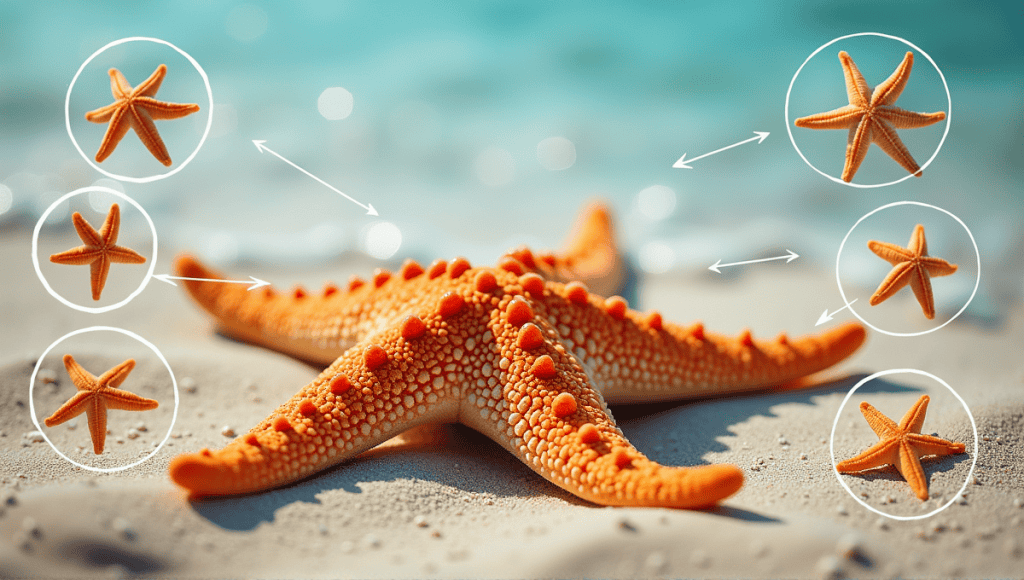As a software development professional with over 15 years of experience, I’ve encountered many teams that find it challenging to conduct effective retrospectives. The starfish retrospective is an excellent framework that can help your team make retrospectives more productive.
It offers a systematic way to determine what’s working, what isn’t, and what needs to be different. You’ll learn how to use this framework and help your team make more progress towards continuous improvement.
Understanding the Starfish Retrospective

The starfish retrospective is an excellent general team improvement activity. I’ve personally used it many times throughout my course of software development in my career. It’s a structured method to guide a team through reflecting on their processes and finding areas to improve.
The starfish retrospective gets its name because a starfish has five arms. Each arm of the starfish represents a different category for the team to reflect on:
- Keep Doing
- Less Of
- More Of
- Stop Doing
- Start Doing
These categories give teams a framework to evaluate their processes and brainstorm new ideas.
It’s most effective when you want to ensure teams provide balanced feedback. It allows teams to provide positive feedback and constructive feedback. Use the starfish retrospective for general team check-ins or after a team completes a project.
I’ve seen teams make significant improvements by using this framework. It encourages open communication and allows you to identify both the strengths and weaknesses of your processes. You’ll learn what you’re doing well and what you’re doing that you could improve.
Again, the process is maximizing process improvement, and the starfish retrospective provides a structured way to maximize it with your team.
Implementing a Starfish Retrospective
The starfish retrospective is easy to conduct. Here’s a step-by-step process to run a starfish retrospective based on my own experience:
- Prepare the space: Create a board with five sections, one for each category.
- Introduce the concept: Explain the five categories to your team.
- Individual reflection: Allow team members to write their thoughts on sticky notes.
- Sharing: Have each person share what they wrote and place it in the corresponding category.
- Discussion: Discuss each item in the category as a team.
- Action planning: Determine specific actions to take as a result.
Here’s the time breakdown for each step:
- Introduction: 5 minutes
- Individual reflection: 10 minutes
- Sharing: 15 minutes
- Discussion: 20 minutes
- Action planning: 10 minutes
You’ll need a whiteboard or large paper, sticky notes, and a marker for each person.
As the facilitator, your job is critical. You should guide the conversation, ensure each team member speaks, and keep the group focused. The key is to create an environment where the team feels comfortable providing open and honest feedback, while also keeping the conversation actionable.
Here are a few tips to facilitate the conversation effectively:
- Remain neutral and do not influence the conversation.
- Manage the time.
- Ask deepening questions to better understand.
- Summarize the key points and any actions you should take.
In my experience, a well-facilitated starfish retrospective will lead to key insights and improvements you can make as a team. It’s a helpful tool in your continuous improvement arsenal.
The Five Segments of This Team Reflection Method in Detail

Let’s explore each section of the starfish retrospective in more detail:
Keep Doing: This section is all about wins. It’s recognizing what you’re doing well and want to keep doing. I’ve found that simply recognizing what’s working well boosts team morale and reinforces good behaviors.
Examples:
- Daily stand-up meetings
- Code review process
- Weekly team lunches
Less Of: Here, you’re not saying the activity or behavior is bad, but you simply want to do less of it. This section helps you optimize your processes.
Examples:
- Long meetings without clear agendas
- Excessive documentation for minor changes
- Frequent context switching
More Of: This is a behavior or activity that is a positive, and you want to do more of it. It’s about recognizing potential.
Examples:
- Pair programming sessions
- Customer feedback sessions
- Team training and skill-sharing
Stop Doing: This means the activity you’re doing isn’t good. This section is critical to eliminate wasteful activities.
Examples:
- Multitasking during meetings
- Last-minute feature additions
- Skipping unit tests to save time
Start Doing: This is the innovation section. What are new things you can do to improve the team?
Examples:
- Implementing automated testing
- Rotating team roles for knowledge sharing
- Regular one-on-one feedback sessions
Analyzing Starfish Retrospective Results
After you’ve completed a starfish retrospective, the next step is analysis. Examine the data. Did many of the items fall into the “Stop Doing” category? If so, the team likely has significant process issues. On the other hand, if most items landed in the “Keep Doing” category, the team is likely executing well but lacking innovation.
Look for patterns. Are the same items recurring across categories? This likely indicates the team isn’t performing well in a particular area.
Rank action items by potential impact and effort. I like to create a simple 2×2 matrix that helps me visualize the highest impact, least effort activities.
Develop a plan to implement the action items. Who will execute each item, and by when? Without this step, even the best idea often falls flat.
- Establish a measure to follow up on later. This will help the team hold one another accountable and ensure the success of the action items. You might even allocate a small portion of the next retrospective to reviewing what happened after the last one.
Remember, the goal isn’t to be perfect. It’s to be better. Small wins add up over time.
Comparing the Five-Column Method to Alternative Reflection Approaches
The starfish retrospective has some key advantages over other options. It’s more detailed than the classic “What went well? What didn’t?” template, providing a more comprehensive framework for collecting feedback.
It’s also more specific than retrospectives like “Start, Stop, Continue.” Adding “More Of” and “Less Of” helps the team give more detailed feedback. I’ve found this helpful when the team is doing pretty well, but they just want to optimize their performance.
However, the starfish retrospective isn’t always the best option. For new teams or after a colossal failure, a simpler format might be more effective. Sometimes, having only five categories feels a bit limiting for a complicated problem.
Use the starfish retrospective when you need:
- A comprehensive understanding of team performance
- Both positive and negative feedback
- To find areas for gradual improvement
You can also mix the starfish retrospective with other techniques. For example, you might use dot voting to prioritize the most important items in each category. You could also start with a “mad, sad, glad” to check in to gauge everyone’s emotions at the beginning of the retrospective.
The key is to choose the retrospective that best fits your team and the current state of the team.
Choose the starfish retrospective when you want:
- A balanced view of team performance
- To encourage both positive reinforcement and constructive criticism
- To identify areas for gradual improvement
Optimal Techniques for Team Reflection and Improvement

Creating a safe environment where team members feel comfortable sharing their thoughts will help make the starfish retrospective effective. To do this, I always set the stage by stating that the purpose of the meeting is to improve, not to place blame.
- Ensure that all team members contribute equally as each team member likely has valuable insights.
- Use techniques like round-robin sharing or ask for anonymous submissions to ensure everyone feels comfortable contributing.
The starfish retrospective often uncovers negative or sensitive feedback. When it does, remember to focus on the issue, not the person.
- Ask the team for solutions rather than problems.
- When the team complains lead them back to the solutions, as this meeting is not about you.
For remote teams, the starfish retrospective can easily be adapted into an online format using a virtual whiteboard and a collaborative document.
- Breakout rooms are also helpful if you have a large team and want to clue into some smaller groups.
Don’t forget to continuously improve the retrospective itself.
- Ask the team for feedback on the retrospective after each meeting and make the necessary adjustments.
- This meta retrospective approach has helped me refine the starfish retrospective over time and make it more effective for my teams.
Finally, remember that the starfish retrospective is a simple framework designed to help you and your team improve.
- Don’t be afraid to deviate from the framework if you believe it will help your team get more value from the meeting.
- With a little practice and some continuous improvement, you’ll quickly discover that the starfish retrospective is one of the most valuable meetings you run with your team.
To Sum It Up
The Starfish Retrospective is an excellent team improvement activity. I’ve watched it turn around underperforming teams to become high performers. It’s an open discussion and a structured reflection activity. Teams discuss what to keep, stop, and start doing.
The key is getting everyone to participate honestly and ensuring the discussion leads to actionable answers. However, always adjust the activity as needed for your team. With a little experience, the Starfish Retrospective will become a key driver of continuous improvement and success.






